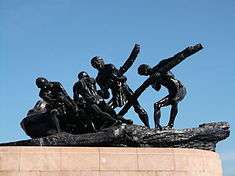D. P. Roy Choudhury
| D. P. Roy Choudhury | |
|---|---|
| Born |
June 15, 1899 Tejhat, Mirpur district, British India |
| Died | 15 October 1975 (aged 76) |
| Occupation |
Painter Sculptor |
| Known for |
Bronze sculptures Triumph of Labour Martyrs' Memorial Patna |
| Spouse(s) | Dolly |
| Awards |
Padma Bhushan Order of the British Empire Lalit Kala Akademi Ratna |
Debi Prasad Roy Choudhury (1899–1975) was an Indian sculptor, painter and the founder chairman of the Lalit Kala Akademi.[1] He was known for his bronze sculptures, including Triumph of Labour and Martyr's Memorial, and is rated by many as one among the major artists of modern Indian art.[2] He was a fellow of the Lalit Kala Akademi, selected in 1962. The Government of India awarded him the third highest civilian honour of the Padma Bhushan, in 1958, for his contributions to Art.[3]
Biography

Roy Choudhury was born on 15 June 1899 at Tejhat, in Rangpur in the undivided Bengal of the British India (presently in Bangladesh), and did his academic studies from home.[4] He learnt painting from Abanindranath Tagore, the renowned Bengali painter, and his earlier paintings showed influence of his teacher.[5] Turning to sculpting, he initially trained under Hiromony Choudhury, and later, moved to Italy for further training.[1] It was during this period, his works started to gather western influences. Returning to India, he joined the Bengal School of Art for further studies. In 1928, he moved to Chennai to join the Government College of Fine Arts, first as a student and then worked there as the Head of the Department, vice principal and the principal till his retirement in 1958. It was during his days at the Chennai College, he was honoured by the British Government with the title of MBE, in 1937.[1] When Lalit Kala Akademi was founded in 1954, he was appointed as the founder chairman.[6] He also served as president of the UNESCO Art Seminar conducted in 1955 at Tokyo and the Nikhil Bharat Bangiya Sahitya Sammilani of 1956 staged at Chennai.[4]
Roy Choudhury, reported to be influenced by the works of the French sculptor, Auguste Rodin,[7] had his first solo exhibition in Kolkata in 1993 after which had several exhibitions in India, including Birla Academy of Art and Culture, Kolkata, Jehangir Art Gallery, Mumbai, National Gallery of Modern Art, Delhi and Lalit Kala Akademi, New Delhi, among others.[1] He is known for large size outdoor sculptures, such as Triumph of Labour, and the statue of Mahatma Gandhi, both at Marina Beach, Chennai,[8] Martyrs' Memorial in Patna, When Winter Comes and Victims of Hunger, both bronze statues,[9] Dandi March statue in Delhi[10] and The Temple Entry Proclamation by Chithira Thirunal Balarama Varma at Thiruvananthapuram.[2] An Inmate of Harem, Ras Leela, A Dramatic Pose of a Man in a Large Cloak and Hat and The Tribune are some of his notable paintings.[1] His works are displayed at Government Museum, Chennai, National Gallery of Modern Art, New Delhi, Srichitralayam at Jaganmohan Palace, Salar Jung Museum, Hyderabad and Travancore Art Gallery, Kerala[2] and are featured in many books, Indian Masters, Volume I,[11] The Two Great Indian Artists[12] and Art and Aesthetics of Deviprasad being some of them.[13] He also published a book, Devi Prosad Roy Chowdhury, co-written by Jaya Appasamy,[14] and some of his students such as Nirode Mazumdar and Paritosh Sen later became known artists in their own rights.[1]
In 1958, the Government of India awarded him the Padma Bhushan, the third highest Indian civilian honour.[3] He received the Lalit Kala Akademi Fellowship in 1962 and, six years later, Rabindra Bharati University, Kolkata, honoured him with DLitt (honoris causa), in 1968.[4] Choudhury, who was married to Dolly,[15] died on 15 October 1975, aged 76.[4]
See also
References
- 1 2 3 4 5 6 "An Artist of Many Colours". Presentation. Slide Share. 2016. Retrieved March 3, 2016.
- 1 2 3 "Tribute to the King". The Hindu. 29 January 2016. Retrieved March 3, 2016.
- 1 2 "Padma Awards" (PDF). Ministry of Home Affairs, Government of India. 2016. Archived from the original (PDF) on November 15, 2014. Retrieved January 3, 2016.
- 1 2 3 4 "Artist Profile". Goa Art Gallery. 2016. Retrieved March 3, 2016.
- ↑ "D.P Roy Chowdhury". GK Today. 2016. Retrieved March 3, 2016.
- ↑ S. B. Bhattacherje (2009). Encyclopaedia of Indian Events & Dates. Sterling Publishers. pp. 222 of 613. ISBN 9788120740747.
- ↑ "Virtual Galleries — Modern Sculptures". National Gallery of Modern Art, New Delhi. 2016. Retrieved March 3, 2016.
- ↑ "A stroll could be a learning experience too". The Hindu. 30 October 2011. Retrieved March 3, 2016.
- ↑ "When winter comes". Chennai Museum. 2016. Retrieved March 3, 2016.
- ↑ "Photographer's Note". Trek Earth. 2016. Retrieved March 3, 2016.
- ↑ Bijoy Krishna Das (Editor) (1920). Indian Masters, Volume I. Lakshmibilas Press, Calcutta. p. 76. ASIN B00GZZK5RM.
- ↑ Prasanta Daw (1978). The Two Great Indian Artists. Firma KLM. p. 114. OCLC 4389232.
- ↑ Prasanta Daw (1998). Art and aesthetics of Deviprasad. Indian Society of Oriental Art. p. 16. OCLC 39130016.
- ↑ Devi Prosad Roy Chowdhury, Jaya Appasamy (1973). Devi Prosad Roy Chowdhury. Lalit Kalā Akademi. p. 40. OCLC 2439345.
- ↑ Bijoya Ray (2012). Manik and I: My Life with Satyajit Ray. Penguin UK. p. 624. ISBN 9788184757507.
External links
- "A Dramatic Pose of a Man in a Large Cloak and Hat". A Painting by Debi Prasad Roy Choudhury. Invaluable. 2016.